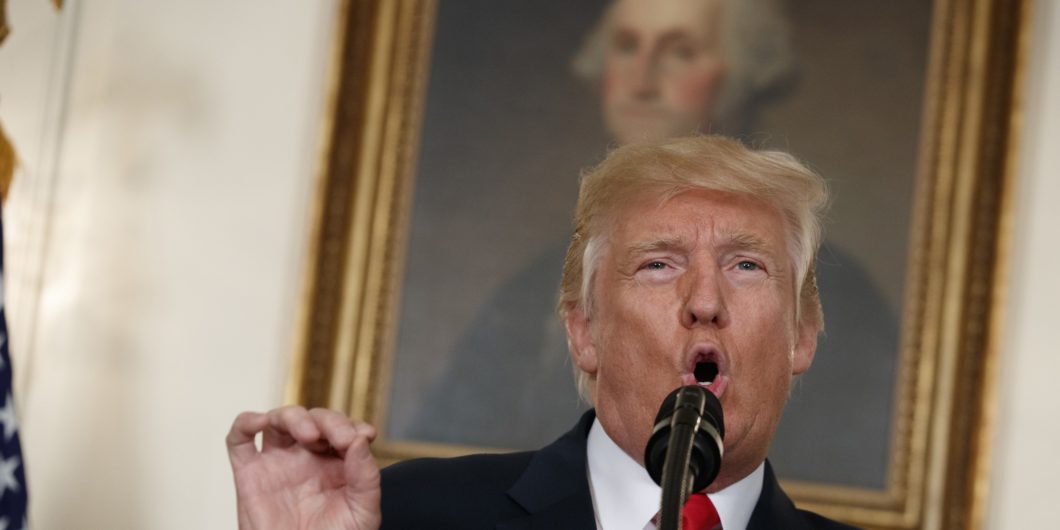The Leadership Needed for Real Recovery
The curve has been flattened, and we seem to have reached the apex of COVID-19 infections in the United States. Public health officials are now advancing two intermingled futures while we await more advanced therapeutics or a vaccine in a year or more. One features diagnostic testing, hyper-aggressive containment, and an army of public health officials conducting contact tracing of the infected. The other sees a temporary relaxation of such methods followed by intermittent returns to total lockdown should infection numbers again increase. It is not clear that either of these overlapping pathways forward will end the epidemic. Nor are they likely to allow Americans to return to lives of productivity, shared burdens, and a general sense of wellbeing.
Sadly, President Trump, siding with his lead public-health officials, has chosen to endorse the gargantuan task of incessant diagnostic testing, containment, and contact tracing rather than following what appears to be his instinct and looking elsewhere for guidance as he seeks to reopen the country. Tragically, this might be the first time in his presidency when he lacked the courage to follow his instincts. It may, unless quickly reconsidered, prove his and the country’s undoing.
Following General George Washington’s Approach
We’ve already put in place many traditional tools of epidemic control: isolation and quarantining of the infected, national barriers to the movement of those who might be diseased (both were tragically too late due to misinformation from abroad), the fleeing of the affluent from densely packed urban environments to the countryside, and environmental mitigation strategies including the simplest, hand washing. We also very much look forward to making use of prophylactics and therapeutics when they are developed, just as we still await vaccines for other viral diseases like HIV/AIDS.
In addition to these proven methods, Americans and others around the world have, without debate and bereft of the most essential information, made use of a wholly novel strategy: the universal “quarantining” of both the healthy and the diseased. This approach has had devastating effects on the social and economic lives of two-thirds of Americans and has likely harmed the long-term health of many citizens in most advanced economies due to absent or postponed essential healthcare and the general decline in health resulting from increased levels of poverty. Before continuing this irrationally destructive behavior, we must consider changing course and making use of the most potent arrow in the quiver of traditional epidemic control methods: the intentional building up of community-wide (herd) immunity through the controlled increase in infection, particularly among the young and healthy. We should do so because once an epidemic has broken out, the only means to end it is by “starving” the virus of hosts, whether it be achieved through widespread natural or, better still, controlled infections or vaccinations.
Indeed, the current risk profile of this virus provides an ideal candidate for making controlled, selective, and intentional use of this method among America’s healthy young women and men. In fact, we’re already unintentionally doing so among essential workers.
If we were to pursue herd immunity, we would be acting in the shadow of a compelling precedent: the nation’s most revered figure and its father, General George Washington. Historian Richard Brookhiser recently noted that Washington’s cool head and sense of responsibility are useful models for us. But Washington’s example can point us in an even more specific policy direction.
Though few seem to be aware of it, the United States was born during a smallpox epidemic that raged, on and off, from 1775 to 1782. As Elizabeth A. Fenn has documented in Pox Americana, the epidemic so threatened the ranks of the Continental Army in 1776-78 that, without the resolute and visionary leadership of General Washington, it would have made the history of an independent American polity very short indeed. In the early months of 1777, Washington began to infect intentionally all of his troops with smallpox using a process known as variolation or inoculation. (Many of the officer corps would have already gone through this procedure and the former British officers and regulars, like Washington, were likely to have been infected naturally.)
For some of our most vulnerable, the present strategy may effectively mean a life sentence without the companionship of loved ones.
In order to build up individual and, more importantly, herd immunity among the troops, biological material from recent smallpox patients was introduced into a small wound made in the skin. For reasons that are still not well understood, the infection that regularly resulted from this process led to relatively low death rates, today estimated around one percent compared to the “natural” infection which resulted in frightening infection-to-death ratios estimated to be between 30 and 40 percent among those of European ancestry, and higher still among African-Americans.
This procedure made it possible for the colonists to wage and win a war for their independence. It was then essential to the new nation’s birth and survival, and it now may be similarly essential to preserving the nation’s long-term economic, social, and physical health. Perilous times often demand visionary statesmanship. President Trump, for the health of his presidency and, far more importantly, for the economic and physical health of the nation’s citizens, must rise to the occasion and consider emulating the actions of his great predecessor by willingly accepting—as great leaders unfortunately must do in war—limited risk for some in order to protect the nation from other, more extensive and longer-lasting dangers.
Washington’s Leadership for Trump’s Crisis
Our forebears had to risk death in a war for independence while protecting themselves individually from death rates of 30 percent or more from smallpox. Our current situation allows us to undertake a strategy analogous to Washington’s, with far less extreme risks. We can permit and encourage the young—and even the younger and healthy middle-aged—to return to work or school while confronting vastly lower levels of risk than their forebears. (And the risks are seemingly becoming even lower as we understand the virus better.) This would allow us to promote herd immunity while at the same time protecting the country—both young and old—from unprecedented, self-inflicted economic and social damage.
If we look at the current strategy’s impact on the young and middle-aged, we see widely differing effects across class lines. The adult children of the affluent, now staying home, putatively for the protection of the most vulnerable and for the “common good,” are being unnecessarily protected (and inconvenienced). More to the point, they are unable to act, as no doubt many might wish to do, in a manner that would benefit their vulnerable and isolated older family members. Meanwhile, a virtual war is being fought in hospitals, on the streets, in factories, in grocery stores, on delivery routes, and on farms, mostly by the working and middle classes. (The great and noble exceptions to this class division are the country’s young—and old—doctors, nurses, and health professionals who have willingly and valiantly manned the front lines.)
Another portion of the young and middle-aged, due to their inability to work from home, have been or soon may be forced out of work as case numbers are likely to rise again. While the affluent are often merely inconvenienced, the working-class bears the heaviest costs of national suppression: those doing essential work are exposed to the virus, and are the only ones building up herd immunity from which the whole society will benefit. These classes are also the ones disproportionately bearing the economic hardships of the shutdown of economic and social life. It should come as no surprise that those bearing the heaviest costs of our current policies and those promulgating and supporting them typically don’t socialize or vote in common.
This inequity of sacrifice is reflective of those made in the Vietnam War. It was unconscionable then, and should not continue today. Accordingly, if all healthy young men and women from all socio-economic classes were to be allowed and encouraged to rejoin the workforce and return to college, the most vulnerable of Americans would likely be better protected than under the current, overly broad shelter-in-place policies.
An essential community-wide immunity would continue to develop among those working in essential services with hopefully far fewer older workers being forced to the front lines. But this policy would also help build immunity up among other social groups and economic classes as schools and more businesses are able to reopen while serving a far larger number of customers and clients than is anticipated in Phase One of the President’s plan. For example, strong and healthy college athletes could return to otherwise deserted campuses in the early summer to live and practice together without social distancing, while being isolated from the surrounding population. These young, healthy men and women would become our 21st-century Continental troops, and would deserve our thanks.
Such an approach would not suffer from the uncertainty associated with the likely frequent returns to widespread mitigation and lockdowns predicted by both prominent public health models. Spikes in infection rates, especially among the young, can’t be permitted intermittently to close society and the economy back down. Only hospital admissions might be used in this way. (School-aged children with middle-aged or older parents or those living in multi-generational households may present a perplexing and likely geographically varied challenge.)
Moreover, we are beginning to learn how much wider-spread asymptomatic infections actually are, as antibody tests suggest 20 percent of New Yorkers may have been exposed. This is an encouraging sign for a more rapid development of herd immunity than one might have anticipated a few weeks ago. Some now believe that Stockholm, where social distancing has been minimal, may reach it by the end of May. (And if Stockholm and New York City have both arrived at the same 20 percent infection rate in mid-April, despite following such radically different mitigation approaches, what does this tell us about the efficacy of the far more onerous strategy pursued in New York City?) This emerging data about general exposure, the current hospitalization rates of the young and younger middle-aged in New York City, and the overall rates of death from all causes indicate that younger populations should be able to go safely back to relatively normal lives.
With or without a widely available therapeutic or vaccine, only widespread community-wide immunity (likely over 60 percent of the population), can allow the vulnerable members of our society to return safely to lives outside of the narrow confines of their homes or retirement communities. Under the scenarios advanced by dogmatic and narrowly focused public health professionals, America’s vulnerable, along with everyone else, will, to varying degrees, be intermittently locked down for a year or more. In some cases, for our most vulnerable, this may amount effectively to life sentences without the companionship of their loved ones who will likely lack an immunity that would have permitted them to spend time safely with their older parents and grandparents. Is this uncertain future really the one we want to impose on them?
Only the President can stop this by following in the footsteps of General Washington and, in this instance, aggressively encouraging (rather than actively discouraging) the states to open up immediately for the healthy young and middle-aged to return to work, socialization, and college. This is the time for greatness and as some states begin to take the first steps, only the President can help assist governors in returning all the country’s citizens to fulfilling and productive lives, with costs equitably shared across socio-economic lines, thus restoring a sense of wellbeing in the company of vulnerable family members.

